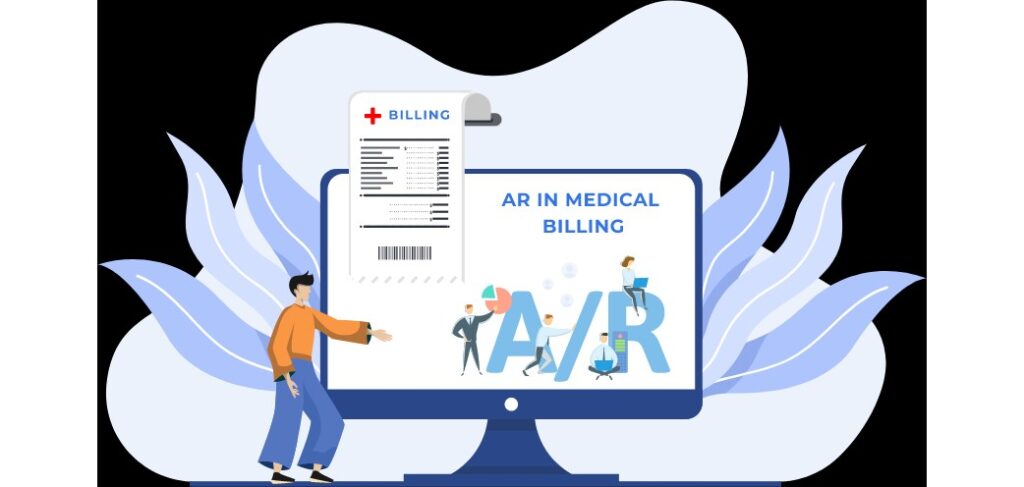After the country witnessed some remarkable medical reforms, healthcare providers and US medical billing companies found it extremely difficult to come up with new challenges. Despite their efforts to adapt to these changes, the impact was significant enough that US medical billing companies are struggling to manage medical Billing services. Managing AR (Accounts Receivable) has become a tough job as operating costs rise and the number of patients with high-deductible health plans increases. So let’s discuss in detail what is Accounts Receivable (AR) in Medical Billing?
The primary goal of healthcare accounts receivable management is to maximize cash flow into the medical or dental practice by minimizing the collection period and associated costs. In the Medical Billing Process, every business must track and obtain its Accounts Receivable (AR). An account receivable is the amount owed by a customer to a business after its services have been rendered and billed. This is a critical commercial aspect of medical institutions such as hospitals, clinics, and private practices. A large number of medical organizations rely on expert medical billing services to ensure that these payments are filed, processed, and received correctly.
Zee Medical Billing Services provides a wide range of healthcare billing services for a variety of healthcare providers, ranging from hospitals to small practices. We aim to ease our clients’ administrative burdens so that they can focus on what is most important: a patient’s health and recovery.
Accounts Receivable (AR) in Medical Billing
Accounts Receivable (AR) is the money owed to Providers or medical billing companies for medical care provided to patients. The generated invoices are sent to insurance companies or patients for payment. It is essential that staff monitor the AR and ensure that payments are received on time.
Billing in accounts receivable
If your business provides goods or services without requiring full payment upfront, this unpaid money is categorized as accounts receivable (AR). The process of sending invoices, collecting payments, and pursuing unpaid balances makes up the AR billing system the company most likely already follows.
How Is Medical Accounts Receivable Unique?
Accounts receivable in healthcare refers to the money owed to healthcare providers and insurance companies for services rendered to patients during a given fiscal year. Because of the amounts owed, the involvement of insurance companies, and the increased risk of late payments, it is distinct from AR in other industries.
Accounts receivable in healthcare, like any other industry, lose significant value over time. The specific threat to medical organizations stems from the rise of high-deductible health plans, which shift financial responsibility to patients rather than insurance companies. Because of this significant financial burden, many healthcare facilities presume to receive payment for only one-fifth of what their patients owe.
For medical companies, these outstanding partially paid bills can lead to limited cash flow, an inability to keep up with operating costs, and, in some cases, bankruptcy. Thus, an effective AR process is paramount for healthcare organizations to stay afloat.
What is Accounts Receivable (AR) process?
It is recommended that a company establish an AR process to determine which customers have already paid and to identify any payments that are unpaid. The procedure is a straightforward sequence of events that makes Receivables traceable and manageable. The AR Process is also known as the O2R Process, which stands for Order to Receive.
Four Main Steps for AR Process:
- Establishing Credit Practices
- Invoicing Customers
- Tracking Payments Received and Payments Due
- Accounting for Accounts Receivables
What is the role of an AR?
An Accounts Receivable employee’s primary responsibility is to ensure that their company receives payments for goods and services and that these transactions are properly recorded. A job description for Accounts Receivable will include securing revenue by verifying and posting receipts and resolving any anomalies.
How Accounts Receivable (AR) in Medical Billing is calculated?
The first measure is the “Calculating Days in accounts receivable” – the average number of days it takes to collect the payments due to the practice.
To calculate days in Accounts Receivable (AR):
- Calculate the average daily charges for the past several months – add up the charges posted for the last six months and divide by the total number of days in those months.
- Divide the total accounts receivable by the average daily charges. The result is the Days in Accounts Receivable.
Medicare usually pays about 14 days after receiving a claim. Some Health Maintenance organizations (HMOs) pay claims at 45 days after receipt, the time allowed by law in some states.
Following figures as benchmarks for medical billing and collections:
- 30 days or less for a High performing
- 40-50 days for an Average performing
- 60 days or more for a Below Average
How to collect Accounts Receivable (AR)?
There are some tips to Improve Accounts Receivable Collection
- Create an A/R Aging Report and Calculate Your ART.
- Be Proactive in Your Invoicing and Collections Effort.
- Move Fast on Past-Due Receivables.
- Consider Offering an Early Payment Discount.
- Consider Offering a Payment Plan.
- Diversify Your Client Base.
Best Practices for Managing Medical Accounts Receivable
Although challenges may appear to be a huge task, there are some tested best practices to help improve your medical AR process:
Collect Payment at the time of Service
Collecting payment at the time of services is the easiest way to keep your AR department running smoothly and ensure that money’s coming in. It’s important to properly vet your customers to ensure they’ve paid other businesses on time; a key indicator that they’ll likely keep up on medical payments, too. It can be helpful to offer early payment incentives, as well, which encourage early and on-time payments for patients.
Maintain patient Relationships and inform them of Financial Responsibilities
A strong business is built on an excellent customer experience—one that’s as transparent and supportive as possible. In fact, more than 50% of consumers claim they would switch healthcare providers for a better customer experience.
By developing positive and open communication with your customers, they’ll feel more comfortable alerting you to any issues or concerns regarding payment. A healthy AR process can make it easier to circumvent and ameliorate issues like insurance claim denials, freeing up time to focus on stronger relationships and better patient care.
Follow-up with Outstanding Accounts
Providing consistent follow-up with outstanding accounts is critical for increasing the likelihood of collecting payment. You should establish a clear collection policy for overdue payments, including periodic courtesy calls, letters of demand, and, potentially, deployment of a collection service. This will arm your AR department with an actionable set of steps should a customer fail to meet deadlines.
Pull an AR Report
Pulling an AR aging report (or a report that breaks down the number of debts and how long they’ve been outstanding) will clue you in on what accounts are delinquent and for how long. This can help you get ahead of any problems with habitual late-payers and gives you the opportunity to intercede with collections or discontinue providing services to avoid credit risks.
Hire Experienced Employees
Medical billing procedures are ever-changing, so it’s helpful to have an experienced AR staff who can stay on top of those updated operations, collection processes, and more. They should be well-versed in how to handle a multitude of both common and unique issues and be able to effectively communicate potential resolutions with customers.
Check-In with Patients and Insurance Providers
Establishing a strong relationship with both patients and insurance companies—and doing your due diligence to ensure the collection of overdue ARs—will help keep cash flow issues at bay. You’ll need to keep detailed accounts of interactions, payment information, and consistent late-payers to adequately stay on top of everything, so make sure you develop a process that runs like a well-oiled machine.
Collect Patient Information
While capturing patient details seems like a common-sense practice, it’s a truly vital piece of successful AR management. But manual, outdated collection processes (e.g. spreadsheets, disparate systems and tools, paper forms, etc.) can make it difficult to capture and update customer information.
That’s why many healthcare organizations have started leveraging automated solutions, as they streamline the previously time-consuming, error-prone process of collecting, searching, and updating client details. They also ensure that those details aren’t duplicated or lost in the shuffle of switching between systems or transcribing them from paper copies.
Automate AR workflow
Manual AR, such as sending out invoicing and processing payments, is tedious and invites otherwise avoidable errors. Accounts receivable automation increases the efficiency of many AR processes, including invoice delivery and payment updates.
Automation can help in the end-to-end process, freeing up precious time for your AR department to focus on high-value tasks that affect your bottom line.
Outsourcing Accounts Receivables Services
Outstanding claims and delayed collections often place added administrative burden on healthcare organizations. Additionally, federal regulations have become increasingly more stringent. This increases the pressure on healthcare organizations to follow up on denied or appealed claims. Incorrect or irrelevant medical coding is the foremost reason for medical claim denials.
Outsourcing healthcare accounts receivable services to Zee Medical can help your healthcare organization effectively deal with your accounts receivables. We will not only save your operational costs but also help in improving the cash flow.
To learn more___
Call @ +1 (224) 999-6997
Or
Get a free no-sting attached billing services quote from ZEE Medical Billing for your practice.





